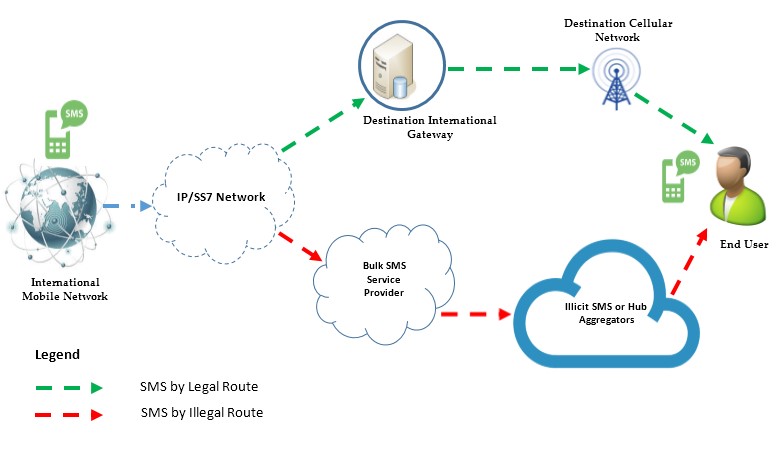
Mobile operators have been fumbling to pave their way through the dark alleys of grey routes. A whopping amount of $18 billion was lost in 2016 worldwide, by mobile network operators (MNO) due to the unauthorized grey routes. Grey routes account for two-thirds of A2P SMS traffic. This means that only one-third of A2P traffic can be monetized by mobile operators. On the other hand, mobile operators who are using SMS firewalls or white route have a reported massive reduction in unauthorized messaging traffic. White route A2P messaging is the key to success as it provides a legitimate messaging service which makes payments to a mobile operator for each message delivered on its network.
A2P messaging can be successfully used to drive customer engagement by exploring various possibilities. A2P SMS sector is projected to grow by 36% on an annual basis, thus having vast potential for the telecom operators to monetize and increase their profits. The following ‘use cases’ will throw some light on the uses of a white route as an A2P messaging monetization solution.
Use cases on white route monetization platform deployment:
- A leading operator in Norway has about 3.4 million subscribers. Adoption of white routing has shown positive results in the messaging traffic as well as the messaging revenue. The ARPU (average revenue per user) increased from $0.10 to $0.50.
- Another MNO in Africa with a subscriber base of 20 million saw an increase in SMS price from €0.002 to €0.016 and an uplift in revenue of €17 million per year after the white route deployment.
- Leading MNOs in the Middle East have augmented their A2P SMS revenues by implementing different pricing models for different A2P use cases for their users. Using a high level of quality control for the traffic they used a spam filter to direct revenue generating traffic into the MNO’s network. Filtered out fraudulent traffic and ensured that the local regulations were followed. As a result of this, the MNO in the Middle East was able to distinguish the nature of the traffic coming into and terminating on its network.
How grey routes work and possess a threat to MNOs?
A global SMS system consists of A2P connectivity network, and in most cases the MNO’s have these approved. The A2P network uses separate connectivity from the P2P network. The main reason behind this is to control spam and grey route. A grey route traffic attempts delivery outside of approved A2P connections into the MNOs.
Such traffic leverages the P2P network to avoid MNO fees or approval processes. These grey routes also leverage the sim farms that are connected to computer servers instead of mobile devices. These sim farms are an attractive option for some messaging businesses as the farms provide a cheaper alternative. Messages from them may be bounced from one service provider to another to avoid legitimate operator connections. MNO’s block such sim farms and take appropriate measures.
The mobile operators apply a termination fee to SMS traffic entering their network from another network. This is done through standardized agreements. As there are many signals that flow between various operators, the SS7 networks can be left open.
In the P2P messaging, the traffic between two MNOs is balanced and hence the termination fees effectively cancel each other. Grey routes take advantage of this in case the originator is outside the country. When thousands of “local” or national phone numbers of SIMs in the SIM-farm are levered, they appear as a P2P message bound for subscribers with a local origination number. Hence the A2P traffic suffers as it travels several hops into the destination operator.
Enterprise customers may pay a lower price, but the traffic has a relatively low chance of delivery. Apart from sim farms, global title scanning also possesses a threat from the grey route. The fraudsters mimic the GT of the operator in order to terminate on the network, and it is made to look like operator’ own traffic.
Conversion and integration to white route A2P messaging
The key to any successful white route A2P messaging deployment is considering various levels of protection and monetization opportunities. Telecom operators should not only consider their current needs but also incorporate their future needs as the industry evolves. Having a partner who provides an apt A2P white route solution will lead to optimal setup and performance for the SMS firewall.
Infrastructure
Telecom operators who wish to covert from grey routing to white routing should have the required infrastructure in place. Either a local infrastructure or a cloud based system should be present for the conversation to take place. Operators having the proper infrastructure in place, can easily go forward with the conversion process.
Legal Considerations
Be aware of the regulations concerning the filtering practices. Various regulations can be placed by the national regulators. Know these legal considerations thoroughly as there can be restrictions even on the location of the implementation and SMS data storage.
Business Considerations
Grey routing makes a huge loss to the revenue, and hence white routing is looked upon as the required solution. Before deployment of the white route, the telecom owner should be prepared with a business plan having the forecast of the expected revenue generation after the deployment of the white routing system.
Commercial Considerations
Commercial considerations for the operator will include, having a new pricing policy to increase profits and market share. The policy should not hamper or destabilize the market.
Technical Considerations
The conversion process from grey routing to white routing can be carried forward for both the solutions like a local (on-premise) solution or a cloud based solution.
Operational Considerations
Operational considerations include handling the processes in-house or outsourcing them. Whatever the operational system is present with the operator, the conversion from grey routing to white routing should be easily done.
Guide to Deploy A2P Messaging Monetization Solution
Monetizing the A2P revenue by eliminating the grey routes will provide a secure environment to subscribers and a smoother customer experience. Step by step implementation as mentioned below remains the key for successful monetization.
Network audit: The MNO’s are advised to do a thorough audit or profiling of their network to understand the shortcomings.
Implement an SMS firewall: MNO’s must ensure that they have the blocking control in place. They can either maintain the filter internally or can find a partner to get it done for them. Manual filters must not be maintained.
Connect to aggregators: Some things are left best to experts. MNO’s can connect to aggregators to combat the fraud. It can include some local and few international aggregators.
Key Elements of A2P Monetization
- SMS Firewall
A Firewalls identifies, filters and blocks unwanted and unpaid SMS traffic. Unless detected, such traffic infiltrates the network and affects the subscribers. Operators are advised to install an SMS firewall considering the approach of monetization. Install a firewall that identifies and filters even the disguised A2P messages that pass into the network through domestic P2P channels.
Signaling based firewalls have basic screening capabilities and can detect some amount of spam and fraud. It is not an efficient option for A2P monetization.
Gateway-based firewalls are the on-premise hardware-based solutions. Although they can offer better filtering capabilities for A2P detection, it involves high CAPEX and OPEX requirements.
Integrated solutions are again in-house based systems offering a limited subset of blocking features integrated on an STP or SMSC.
Reporting based firewalls have powerful analytical tools, but lack in the blocking function. Hence you cannot expect to the fake protection and MO filtering.
IP based solutions are specially involved for security and signaling analysis than revenue assurance. Again, they lack in identifying the grey routes and providing faking protection.
Home routing solution works as a network node within the operator’s network, even if hosted as a cloud service. This solution offers the maximum benefit by efficiently protecting from faking. It also helps in protecting customers when in roaming mode.

A good firewall solution is critical to achieving full monetization of A2P. Again, the MNO’s should make sure that the firewall setup is updated to tackle the constantly evolving fraud and misuse techniques.
- Tracking and Reporting System
Tracking and reporting system involves a combination of hardware and software allowing the mobile operators to monitor and administer SMS traffic in their network. All the reports are then prepared and analyzed based on the real-time monitoring. This tracking system reports:
- Traffic received
- Traffic volumes
- The originating partner
- Delivery routes
- Applicable fees
Types of Infrastructure for Solution Deployment
The infrastructure for the A2P messaging solution can be either a:
- Standalone hardware device
- Managed service hosted on a cloud
The conversion for grey route A2P messaging to the white route is supported by both the above-mentioned options. However, deploying a cloud based solutions comes with its added advantage of reduced CAPEX and OPEX. Cloud based systems reduce the cost as there is no requirement of upfront investments in infrastructure and Human resource, as opposed to the standalone hardware solutions. As a result, the overall A2P messaging revenue increases due to low service startup costs.
A2P Messaging Vendor Requirements
MNO’s looking to integrate white route A2P messaging solutions should look for the following qualities in the service providers/vendors:

Global Reach: MNO’s should understand their reach requirements and type of connectivity required. Some vendors are local while others focus on global connectivity.
Availability: Choose a vendor who caters to the availability requirement of the MNO’s through network architecture, service level agreements and service availability.
Performance: A vendor’s performance or the scalability can be determined based on the number of messages they process in a month. Comparisons done according to the set benchmark can help the operators select the vendor based on the optimum scalability requirements.
Quality: Quality can be determined by analyzing the delivery rate of the messages and the time of the message to cross the SMS platform. Understand the delivery rates provided by the vendors and compare the same.
Security: The vendor’s security protocol can be analyzed through their information security program, the privacy of proprietary or personal data, supporting documentation, standards used and the types of controls used to support general data protection.
Summarizing requirements for A2P messaging monetization solution
Converting grey route A2P messaging to the white route is a good business strategy as it helps in:
- Controlling revenue leaks
- Generating revenues from enterprise engagement
- Increasing profits from roaming partners
- Gaining control over the network traffic
- Providing a secure environment to the network subscribers
- Increasing customer loyalty






